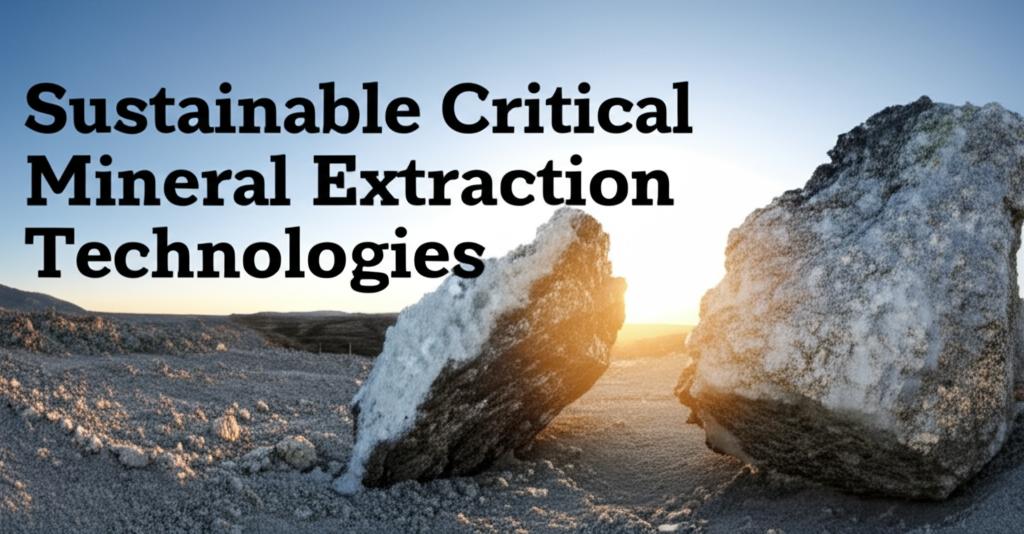The soaring demand for critical minerals, driven by the global shift towards clean energy technologies like electric vehicles, wind turbines, and solar panels, presents a significant challenge. These materials are essential for a sustainable future, yet traditional extraction methods often carry substantial environmental and social costs, including habitat disruption, water pollution, high energy consumption, and significant waste generation. This has spurred innovation towards more sustainable extraction technologies and responsible mining practices.
Moving Beyond Traditional MethodsConventional mining techniques, while effective in extracting minerals, face increasing scrutiny due to their environmental footprint. Issues like large land use changes, particularly with open-pit mining, water depletion and contamination, substantial greenhouse gas emissions from energy-intensive processes, and the generation of vast amounts of waste (like tailings and waste rock) necessitate a paradigm shift. Furthermore, the declining quality of ore grades means more material must be processed to yield the same amount of mineral, potentially exacerbating these impacts.
Innovations Shaping Sustainable ExtractionRecognizing these challenges, the industry is actively developing and adopting new technologies and approaches to minimize environmental harm and improve resource efficiency:
- Low-Impact Mining Techniques: Methods like in-situ leaching (or solution mining) are gaining traction. This technique involves dissolving minerals directly from ore deposits underground using chemical solutions, significantly reducing surface disruption and waste compared to open-pit or underground mining. Biomining (including bioleaching) utilizes microorganisms to extract metals from ores, often operating at lower temperatures and generating less pollution than conventional methods.
- Advanced Processing and Separation: Innovations in metallurgy are crucial.
Greener Solvents: Research highlights the potential of green organic solvents, such as deep eutectic solvents (DES) and ionic liquids, in hydrometallurgical processes. These solvents offer advantages like lower toxicity, biodegradability, and high efficiency in dissolving and separating minerals, reducing reliance on harsh chemicals. Examples include using specific DESs to dissolve sulfide minerals or employing environmentally friendly solvents like ethylene glycol. Organic acids, sometimes derived from biological sources like fungi (e.g., Aspergillus niger), are also being used to leach minerals from ores or waste.
Improved Techniques: Enhancements in traditional hydrometallurgical and pyrometallurgical processes aim to boost extraction rates and the purity of recovered materials. Technologies like electrokinetic in-situ recovery (EK-ISR) and high-voltage pulse plasma are being developed to improve metal recovery while potentially lowering energy use. Advanced membrane technologies are also being explored for more efficient purification and separation.
- Automation, AI, and Digitalization: Technology is revolutionizing exploration and operations.
Smarter Exploration: AI algorithms analyze vast geological datasets, drone surveys provide detailed mapping, and geospatial analysis helps pinpoint mineral deposits more accurately and efficiently, reducing the need for extensive physical exploration and lowering costs.
Efficient Operations: Automation, including autonomous haul trucks and drilling systems, enhances operational efficiency, reduces fuel consumption, and improves safety by removing personnel from hazardous areas. Digital platforms integrating sensor data (from drones, satellites, equipment) allow for real-time monitoring and optimization of resource extraction, energy use, and environmental conditions.
- Circular Economy and Waste Valorization: Shifting from a linear "take-make-dispose" model to a circular one is paramount.
Urban Mining: This involves extracting valuable critical minerals from secondary sources like electronic waste, old appliances, and industrial residues. Technologies are being developed to efficiently sort and process this waste – Apple's Daisy robot recovering materials from old iPhones is one example. Specialized modular systems are emerging to recover minerals from e-waste.
Repurposing Waste: Innovations focus on extracting remaining minerals from mine tailings, slags, and waste rock, or repurposing these materials (e.g., using tailings in construction materials like GGBS), reducing landfill needs and creating value from waste streams.
- Energy and Water Management:
Renewable Energy Integration: Mining operations are increasingly investing in solar, wind, and sometimes hydroelectric power, often using microgrids and battery storage, particularly in remote locations. This reduces reliance on fossil fuels and cuts greenhouse gas emissions. Utilizing waste methane from coal mines for power is another strategy.
Water Stewardship: Techniques like closed-loop water recycling are being implemented during mineral processing to minimize water consumption and prevent the discharge of contaminated water.
The Path ForwardThe transition to sustainable critical mineral extraction relies on a combination of technological innovation, robust policy frameworks, and industry collaboration. Technologies enabling precise exploration, efficient low-impact extraction, greener processing, comprehensive recycling, and responsible waste management are key. Integrating Environmental, Social, and Governance (ESG) principles into operations and supply chains is becoming standard practice, driven by investor and consumer demand for ethically and sustainably sourced materials. Blockchain technology is even being explored to enhance traceability and transparency in mineral supply chains.
While challenges remain, including the technical and economic feasibility of scaling new technologies and the need for supportive regulations, the direction is clear. Continued investment in research, development, and deployment of sustainable technologies is essential not only to meet the burgeoning demand for critical minerals but also to ensure the transition to a green economy is itself sustainable and responsible.

